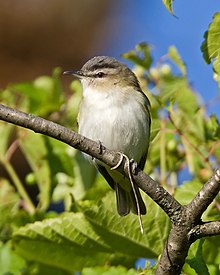Red-eyed vireo
| Red-eyed vireo | |
|---|---|

| |
| In Wisconsin, North America | |
| Scientific classification | |
| Domain: | Eukaryota |
| Kingdom: | Animalia |
| Phylum: | Chordata |
| Class: | Aves |
| Order: | Passeriformes |
| Family: | Vireonidae |
| Genus: | Vireo |
| Species: | V. olivaceus
|
| Binomial name | |
| Vireo olivaceus (Linnaeus, 1766)
| |

| |
| Synonyms | |
| |
The red-eyed vireo (Vireo olivaceus) is a small
"Vireo" is a
Description and systematics
Adults are mainly olive-green on the upper parts with white underparts; they have a red
In the past, the
Measurements:[4]
Both sexes:
- Length: 4.7-5.1 in (12–13 cm)
- Weight: 0.4-0.9 oz (12-26 g)
- Wingspan: 9.1-9.8 in (23–25 cm)
Song
Red-eyed vireos are one of the most prolific singers in the bird world. They usually sing high up in trees for long periods of time in a question-and-answer rhythm. This species holds the record for most songs given in a single day among bird species, with more than 20,000 songs in one day.
Songs generally consist of 1-5 syllables between 2 and 6 kHz.[5] Songs are usually spaced apart by 0.8–1 seconds although at times vireos may sing at a slower or faster rate.[5] Red-eyed vireos have a large repertoire size with one study finding an average of 31.4 song types per bird with one individual singing 73 different song types.[5]
Ecology
This section needs to be updated. The reason given is: some information refers exclusively to South American breeding populations now treated as a separate species, chivi vireo. (June 2022) |

Photo by Vernon R. Martin

The breeding habitat of the red-eyed vireo is in the open wooded areas across Canada and the eastern and northwestern United States. These birds migrate to South America, where they spend the winter. The Latin American population occur in virtually any wooded habitat in their range. Most of these are residents, but the populations breeding in the far southern part of this species' range (e.g. most of its range in Argentina, Uruguay, Paraguay and Bolivia) migrate north as far as Central America.
In northern Ohio, it seems to return to breed at about the same time as one century ago; but it may leave for winter quarters one or two weeks earlier at present than it did in the past.[6]
Red-eyed vireos
They also eat berries, especially before migration, and in the winter quarters, where trees bearing popular fruit like
The nest is a cup in a fork of a tree branch. The red-eyed vireo suffers from nest
Vagrancy
The red-eyed vireo is a visitor to some western states, especially California.[12] This vireo is one of the more frequent American passerine vagrants to Europe, with more than one hundred records, mainly in Ireland and Great Britain.
Footnotes
- . Retrieved 12 November 2021.
- ISBN 978-1-4081-2501-4.
- ^ "Vireo". Oxford English Dictionary (Online ed.). Oxford University Press. (Subscription or participating institution membership required.)
- ^ "Red-eyed Vireo Identification, All About Birds, Cornell Lab of Ornithology". www.allaboutbirds.org. Retrieved 2020-09-27.
- ^ S2CID 56367418.
- ^ Henninger (1906), OOS (2004)
- ^ Machado (1999)
- ^ Foster (2007). Cymbopetalum mayanum (Annonaceae) is visited far less frequently.
- ^ Pascotto (2006)
- ^ Haemoproteus vireonis (Basto et al., 2006) and perhaps some other species (Londono et al., 2007).
- ^ Basto et al. (2006), Londono et al. (2007)
- ^ "Red-eyed Vireo "Vireo olivaceus" | Boreal Songbird Initiative".
References
- Basto, Natalia; Rodríguez, Oscar A.; Marinkelle, Cornelis J.; Gutierrez, Rafael & Matta, Nubia Estela (2006). "Haematozoa in birds from la Macarena National Natural Park (Colombia)". Caldasia 28(2): 371-377 [English with Spanish abstract].
- Foster, Mercedes S. (2007). The potential of fruiting trees to enhance converted habitats for migrating birds in southern Mexico. Bird Conservation International 17(1): 45–61.
- Henninger, W.F. (1906). "A preliminary list of the birds of Seneca County, Ohio." Wilson Bull. 18(2): 47–60. DjVu fulltext
- Londono, Aurora; Pulgarin-R., Paulo C. & Blair, Silva (2007). "Blood Parasites in Birds From the Lowlands of Northern Colombia." Caribb. J. Sci. 43(1): 87–93.
- Machado, C.G. (1999). "A composição dos bandos mistos de aves na Mata Atlântica da Serra de Paranapiacaba, no sudeste brasileiro [Mixed flocks of birds in Atlantic Rain Forest in Serra de Paranapiacaba, southeastern Brazil]." Revista Brasileira de Biologia 59(1): 75-85 [Portuguese with English abstract].
- Ohio Ornithological Society (OOS) (2004). "Annotated Ohio state checklist. Version of April 2004"
- Pascotto, Márcia Cristina (2006). Avifauna dispersora de sementes de Alchornea glandulosa (Euphorbiaceae) em uma área de mata ciliar no estado de São Paulo [Seed dispersal of Alchornea glandulosa (Euphorbiaceae) by birds in a gallery forest in São Paulo, southeastern Brazil]." Revista Brasileira de Ornitologia 14(3): 291-296 [Portuguese with English abstract].
External links
- Red-eyed Vireo - Vireo olivaceus - USGS Patuxent Bird Identification InfoCenter
- Red-eyed Vireo Species Account - Cornell Lab of Ornithology
- Stamps[usurped] (for Saint Vincent and the Grenadines, Venezuela) with RangeMap at bird-stamps.org
- "red-eyed vireo media". Internet Bird Collection.
- Red-eyed vireo photo gallery at VIREO (Drexel University)
- "Vireo olivaceus". Avibase.
- Red-eyed Vireo Bird Sound at Florida Museum of Natural History
- Interactive range map of Vireo olivaceus at IUCN Red List maps


